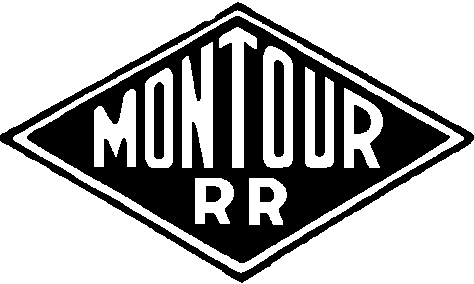 Montour
Railroad
Montour
Railroad 
|
|
Tim
Sposato Stories
Wreck of MTR 76 - 2-Oct-1974 One of the most spectacular accidents in the history of the Montour Railroad as engine 76 was involved in a collision with a flat car carrying an earthmover. Although 76 suffered extensive damage the bottom line is that no one was injured in the wreck - and nothing even derailed. This day started off normally on the Montour Railroad, trains working the line, hauling coal from the mines to Champion. One such train was 76/78/83 West - with 45 loads of coal heading for Champion at 1:40 pm - the train was travelling over the McDonald Viaduct. The engines had cleared the viaduct and had passed the east switch of McDonald Siding. The story can be found in Gene's book on page 128 and is also the subject of the Montour History column in the newest Montour Trail Newsletter. The flat car with the earthmover was rolling eastbound down the main line when it met 76 West. The houses along Rt 980 in the background give some perspective to the location of the collision. 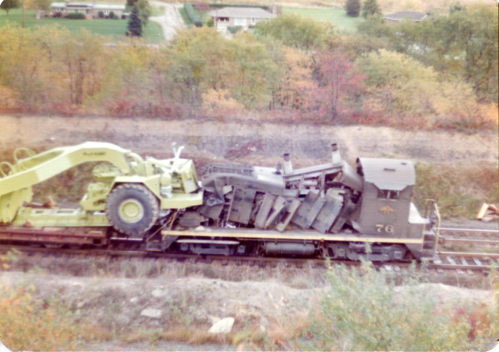 As they met on a straight section of track - the force was all in line with the centerline of the car and engine with no angle to throw the earthmover sideways. I don't see any chains or pieces of chains attached to the earthmover so it was probably sitting loose on the flat car when the flat got away from the workers that were unloading it. What looks like something attached to the earthmover just in front of its wheel is the remains of 76's front hand rail. Physics dictate that when the flat car abruptly stopped as the couplers met - the earthmover kept moving, I doubt that any chains would have slowed it down much..... 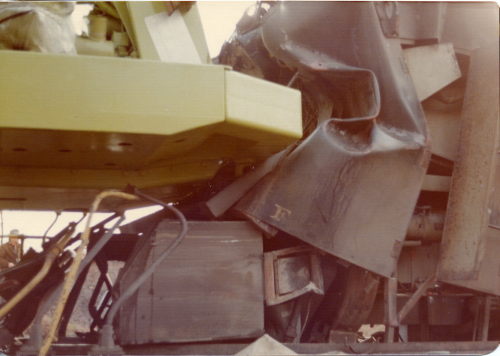 Check out the impression of the front bumper from the earthmover as it smashed into the long hood of 76. And - the results of the earthmover pushing the prime mover and long hood into the cab can be seen in the first picture. Jim Lane and Dave Sherwood were lucky indeed to have gotten out of the cab and "joined the birds" as they flew off the engine just before the collision. I imagine the trainmen in the caboose got quite a jolt as they were stopped dead in their tracks. 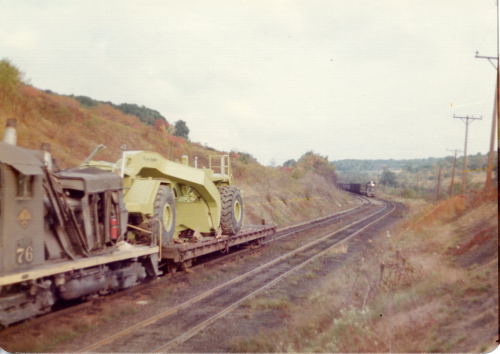 As you can see in this photo - Jim Lane & Dave Sherwood would have had very little warning about the flatcar approaching as it appeared rounding the curve ahead. They would have had to get out of the cab in a real hurry. I doubt those 2 would fit through the cab door at the same time - but I bet they gave it a try...... As 76 was already past the siding switch - The remainder of the train could be uncoupled backed up and pulled around the wreck via the siding to clear the area. It is amazing that with the train behind the engines stretched around the curve coming off the viaduct, that none of the hoppers even derailed. The slow speed and the weight of the loaded cars kept them on the tracks. The pictures came from a packet of photos that Chuck Ross had loaned me to scan. I learned later today that Tim Sposato took all the pictures of the incident. Tim said he will share some details later. Given Big Jim's dislike of heights, he had probably just opened his eyes after crossing the viaduct. This was another case of fortunate timing - if you can call it that. If The flat car had broken away a few minutes earlier or 76West had been running just a little slower- it would have met 76 out on the viaduct. That might have had disastrous results. The incident took place just a few car lengths past the east switch of McDonald Siding. The trailing locomotives would have been sitting on/fouling the switch. After 40 years including stripmining - regrading and new tree growth - the scene looks different now than in the pictures. This is about halfway between the viaduct and the McDonald Transfer track (panhandle connector trail) Google earth/maps shows a big sweeping curve coming off the viaduct. Then a short straight (where the siding switch was located) and a shallow curve before the Transfer Track. The shallow curve is shown in the pictures behind the wreck scene Bryan Seip 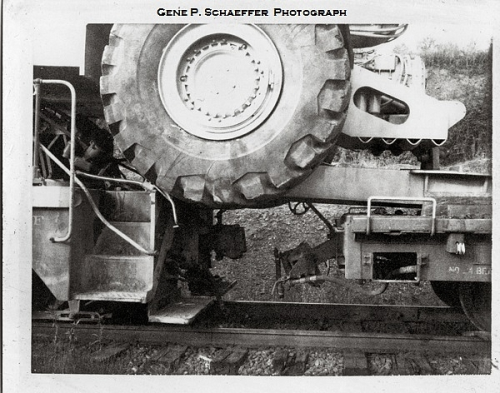 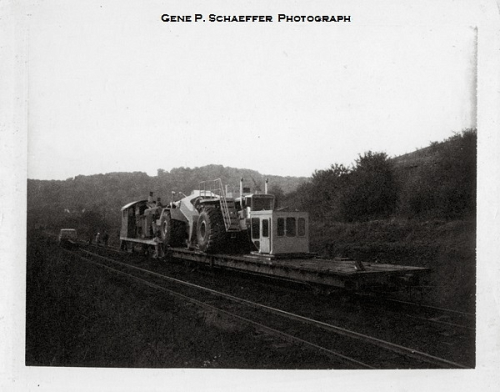 The statement of Montour RR Car Shop employee John Volovich. The typed statement on Montour RR letterhead is dated November 12, 1974 and was done by C.W. Heil - Adjustor, General Adjustment Bureau, 875 Greentree Road, 7 Parkway Center, Pittsburgh, Pa. 15220, telephone 921-0300. John Volovich was 56 years of age. He was employed as a Carman Carpenter for the Montour Railroad at Coraopolis. On Wednesday October 2, 1974 John was told to go to McAdams siding near McDonald to repair or close the doors of a box car that had been loaded by Fort Pitt Metals. They took the company pick up truck, this is his brother Anthony Volovich who is employed as a work inspector. They arrived McAdams shortly after 1P.M. They noticed several men with equipment down the track siding from them. They were about 300 feet or more away. We saw a railroad flat car with a large road grader setting on it. A pick up pulled up and parked near us and the driver got out and started down towards the flat car. I asked this man what they were doing with the grader. He said it was going to be delivered to a coal stripped in the area, Aloe Coal Co. When we first started to watch the men around the flat car, we noticed they were moving the flat car with the grader on it, upgrade on the side track. They had a larger cable attached to it and the flat car and had begun to pull it up grade. While we were talking with the man out of the pick up truck and watching he flat car being moved, we heard some shouting and saw the men around the flat car running around and picking up hands full of dirt and gravel and throwing it on the rails as we noticed the car starting to move down grade. There was no one on the flat car at the hand brake as far as we could tell. We did not see any one jump from the car after it got moving downgrade traveling east. The man with the pick up truck had a two way radio in his truck and I asked him to radio the Bell Telephone dispatcher to contact our dispatcher and tell them about the flat car getting away. The man didn't call anybody to my knowledge. I left immediately, going down the road with my brother to look for the flat car . When we could not see it anywhere we went back to Fort Pitt Metals and had the office girl get the number and place the call to the Montour Junction Dispatcher. I was told the flat car had already collided with our westbound coal train. We went back to finish the repairs on the box car and one of the four men at the scene asked us which way they could go to follow the flat car. We told them and they all left. We finished our job and returned to Montour Junction. My brother and I have read the above statement and it is true to the best of our knowledge. Signed: John Volovich Anthony Volovich Gene P. Schaeffer: If memory serves me correctly, the crew in the caboose of Extra 76 West, Conductor Mike Desko and Brakeman Dan Leonard both stated when the train went into emergency, they were not yet out on the viaduct but could see a big plume of steam rising from where the head end would be as the locomotive radiators burst from being impacted by the earthmover. Litigation went on for many years after this accident. The coal company employees were attempting to move the flat car using a steel cable which broke, and they tried throwing dirt on the rail to stop the car which was now moving on its own. The de-rail at the East End of McAdams was knocked off the rail due to deteriorated tie conditions. Montour car shop employees were at McAdams at the time of this incident and went to the office at Pitt Chemicals to telephone the Montour RR train dispatcher at Coraopolis to report the run-a-way...which by that time they learned it had already collided with the 76 West. Brakeman Dave Sherwood often chuckled that Engineer Jim Lane...(who by the way surprisingly was not dozing off as he often did) was wide awake and met Dave at the door as they both tried to exit the locomotive cab at the same time. Both crew members were rounded men that could only fit in the doorway one at a time. The locomotives were off McDonald Viaduct (luckily) and just passed the switch at the East End of McDonald when the collision occurred. The trailing two SW-9's took the train to Champion after all concerned arrived and investigated the scene. Tim Sposato: About 7pm Oct 2, 1974, our telephone rang; my sister hollered that it was for me. Answering it, the words; “Timmy, we wrecked the #76 today at McDonald” came from my good friend James “Big Jim” Lane. He continued on in detail of how the collision occurred that cloudy, 48 degree afternoon. Jim was filled with excitement throughout the conversation. He wanted to know if I could get some pictures for him before they cleaned up the wreck, of course my answer was a enthusiastic Yes! At first light I was arrived at East End McDonald and gazed upon the unfortunate #76. This view made a great impression on me, still vividly clear to this day. Shortly the yellow RH-1 Dodge van eased eastbound down through McDonald Siding, stopping next to the #76. The gang clamored out and shortly started work, gathering the metal components of the SW9 that had been flung off her during the impact. Soon Fred C. Rauschart (FCR) with a P&LE official, whose name I cannot recall, appeared on the narrow path through the woods from the Transfer Track. Fred & I had known each other now for about 4 years. He nodded and said “Should have known you would be here”. I had commenced taking pictures as the daylight got better from the low bank of the cut on the passing siding side. The switch was in a shallow cut, mainline side being high and steeper. More MRR employees of various departments showed up as did a well dressed older gentleman. This man viewed the wreck for a while as he spoke to FCR. On his departure, he stopped by me and introduced himself as an official of Aloe Coal Company, asking about my taking pictures. I told him they were for my own pleasure at which he expressed interest in having me send him some. After the Coal Co. offical departed, FCR confronted me and said he could take my film, and as many times before, be considered to be trespassing. Then he quickly mentioned that if I provided him copies and not the Coal Company he would allow me to stay. Well, I already knew what side I was on and my agreement came quickly. FCR then had me follow him for a closer look of #76. He also pointed out some views he would like to have me take both inside and out. When I left that day, I thanked Fred for allowing me to be a small part of this event. Later learned that the pictures supplied to FCR did play some part in the investigation and eventual settlement between the two companies. On a final note, I provided sets of prints to the entire crew that was involved in the collision. Interesting now to see that some of those FCR photos ended up in Charley Ross’s collection after all these years. The photos below are two the Jim requested, Engineer side and view from his cab window. 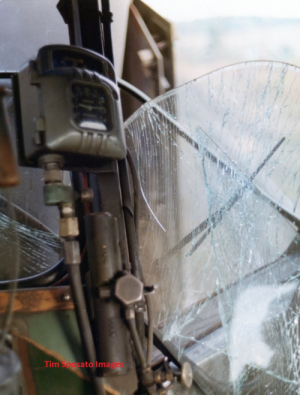 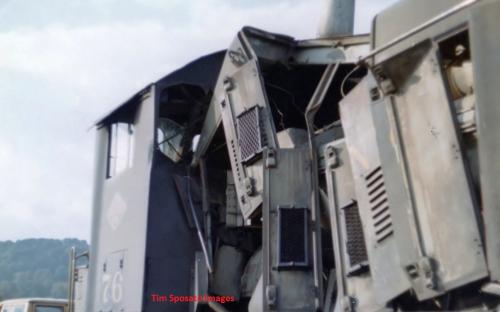 Interesting Facts:
A few notes regarding Montour 76.
|
|